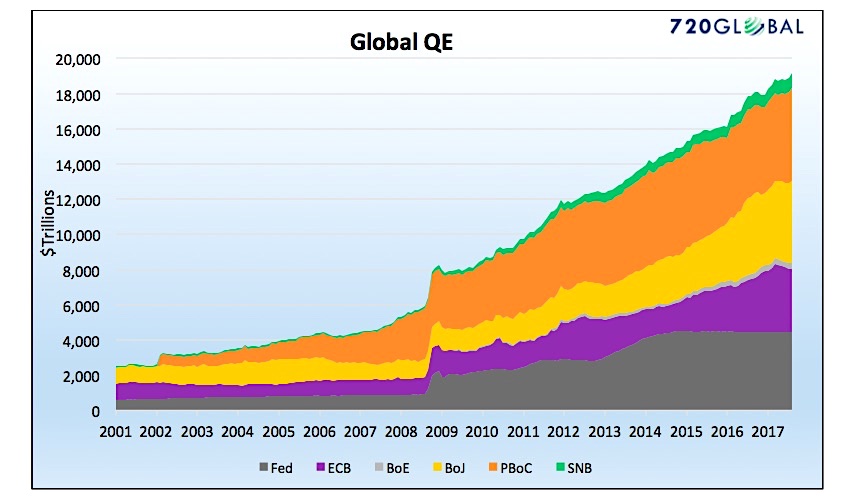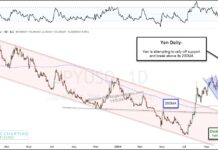A Question for Every Investor
Recently we received the following question from a subscriber:
“If a correction in the stock or bond markets comes, the Central Banks will buy stocks with printed money, like the Japanese Central Bank, etc. Will there ever be a shakeout of the garbage and junk in the system? I am losing all confidence.” –Ron H.
Questions like Ron’s that suggest the decay of capitalism and free markets should raise concerns for anyone’s market thesis, bullish, bearish or agnostic. What stops a central bank from manipulating asset prices? When do they cross a line from marginal manipulation to absolute price control? Unfortunately, there are no concrete answers to these questions, but there are clues.
Global central banks’ post-financial crisis monetary policies have collectively been more aggressive than anything witnessed in modern financial history. Over the last ten years, the six largest central banks have printed unprecedented amounts of money to purchase approximately $14 trillion of financial assets as shown below. Before the financial crisis of 2008, the only central bank printing money of any consequence was the Peoples Bank of China (PBoC).
The central banks’ goals, in general, are threefold:
- Expand the money supply allowing for the further proliferation of debt, which has sadly become the lifeline of most developed economies.
- Drive financial asset prices higher to create a wealth effect. This myth is premised on the belief that higher financial asset prices result in greater economic growth as wealth is spread to the masses. “And higher stock prices will boost consumer wealth and help increase confidence, which can also spur spending. Increased spending will lead to higher incomes and profits that, in a virtuous circle, will further support economic expansion.”- Ben Bernanke Editorial Washington Post 11/4/2010.
- Lastly, generate inflation, to help lessen the burden of debt.
QE has forced interest rates downward and lowered interest expenses for all debtors. Simultaneously, it boosted the amount of outstanding debt. The net effect is that the global debt burden has grown on a nominal basis and as a percentage of economic growth since 2008. The debt burden has become even more burdensome.
The wealth effect is putting riches in the hands of a small minority of the population, with negligible benefits, if any, flowing to the majority of the population. Bernanke’s version of the virtuous circle, as highlighted above, is far from virtuous unless you are in the upper five to ten percent of households by wealth. To understand how a real economic virtuous circle works, we recommend you read our article The Death of the Virtuous Cycle and watch The Animated Virtuous Cycle.
Inflation has been low since 2008 and deflation continues to be a chief concern of most central bankers. Because QE, in all cases, was focused on financial asset prices and not the prices of everyday goods and services, the inflation they aimlessly seek has not occurred.
To summarize our views, largely ineffective monetary policies are providing few economic benefits. They are increasing the debt burden and furthering socially destabilizing trends. Worse, these policies are packed with consequences that lie dormant and have yet to emerge. One of our concerns, which is being heralded as a positive, is the massive distortions in financial asset prices worldwide. Consider a few of these facts below and whether they are sustainable:
- U.S. yields have been among the lowest ever on record dating back to 1776
- U.S. equity valuations have risen to levels rarely observed and from this perch have always been followed by massive losses
- Over $9 trillion in sovereign bonds yields in many European countries and Japan have negative current yields
- European junk-grade debt now trades at yields lower than U.S. Treasuries
- Veolia, a French BBB rated company, recently issued a 3-year bond at a yield of -.026%.
- Italian 3-year government bonds yield -0.337%, despite the 3rd highest debt to GDP ratio of all developed nations (132%)
- Argentina, which has defaulted 6 times in the past 100 years, issued a $2.75 billion 100-year bond paying a paltry 8% interest
- The BOJ owns over 75% of all Japanese ETFs
- The Swiss National Bank owns 19.2 million shares of Apple, or 3% of total shares outstanding, and $84 billion in aggregate of U.S. stocks
Yes, Ron, the central bankers have clearly crossed the line between free markets and government controlled markets. To answer your question about the “shakeout,” we must wait until the inevitable day comes and asset prices are in free-fall. When this occurs, we will learn the full extent of their support and how far they have crossed the line. We like to think the central bankers are willing to endure the short-term pain of such a situation and allow the natural cycle of economies and asset prices to run their course. The reality, however, is that the pattern of their actions in the post-financial crisis era argue that they are unlikely to relinquish their grip. To the extent that authority and power is extended to the Fed through the U.S. Congress, it does not seem likely for career politicians to urge action that may be painful in the short-term but highly beneficial in the long-term.
This premonition was supported by recent statements from the October 2017 Federal Reserve minutes and appointed Fed Chairman Jerome Powell respectively. Fed Minutes: “In light of elevated asset valuations and low financial market volatility, several participants expressed concerns about a potential buildup of financial imbalances,” further “They worried that a sharp reversal in asset prices could have damaging effects on the economy.” Jerome Powell, in prepared remarks to Congress stated: “(the Fed) will respond with force to threats to the nation’s stability.”
Putting two and two together, one can quickly figure out that falling asset prices and the “damaging effects” they will inflict on the economy will not be tolerated by the Fed.
Ron, while we cannot answer your question with certainty, we are relatively confident the Fed and other central banks’ influence on markets will only increase in time as they continue to perpetuate the debt and economic problems they helped create. Naturally, the next question for consideration is to what extent markets may be bigger than the Fed? That is an article for another day.
We love reader questions. Please reach out or submit them in the comments below – we will be happy to respond.
Twitter: @michaellebowitz
Any opinions expressed herein are solely those of the author, and do not in any way represent the views or opinions of any other person or entity.









